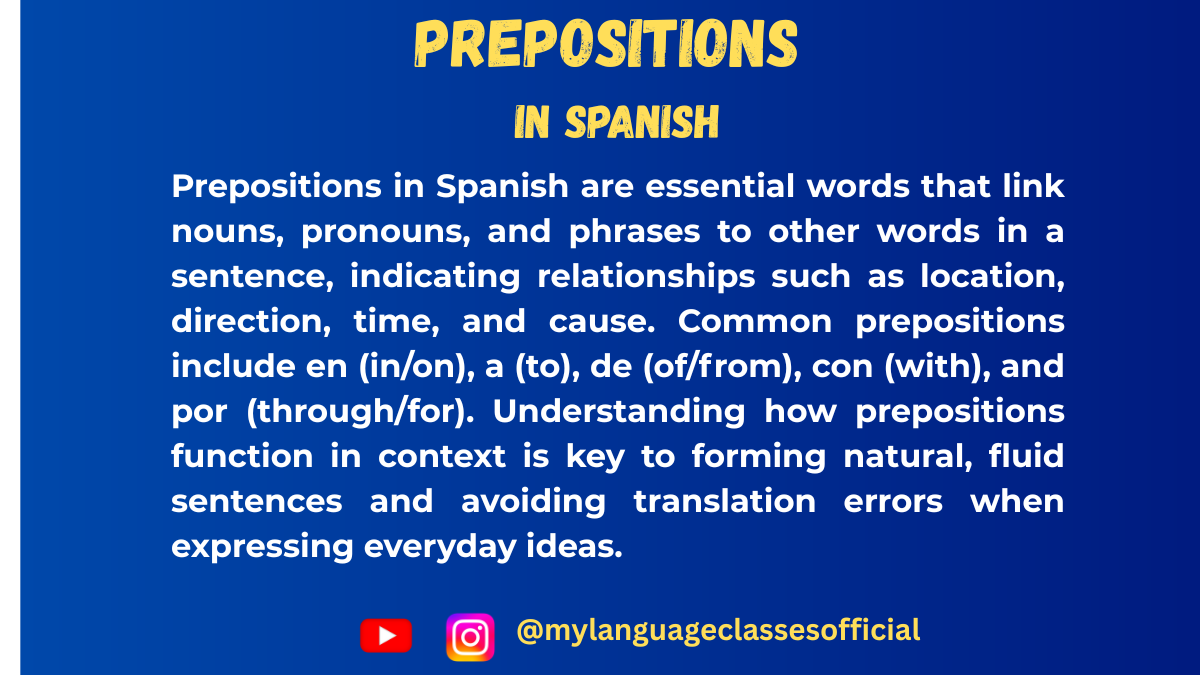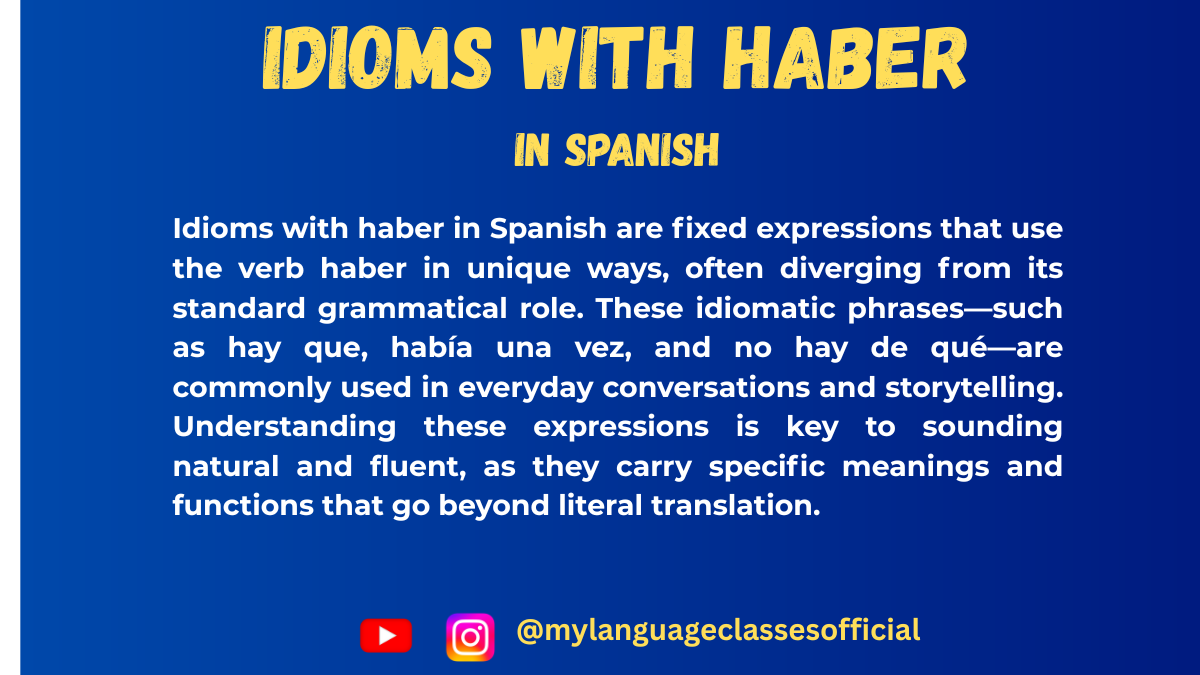Your cart is currently empty!
Tag: Spanish Language Tips
-

Coordinating Conjunctions in Spanish: y, o, pero, sino, and Others
Coordinating conjunctions (conjunciones coordinantes) in Spanish are essential for connecting words, phrases, and clauses that are grammatically equal. They help create fluid and coherent speech and writing. This article will explain the main coordinating conjunctions in Spanish, their uses, and common expressions that feature them in everyday conversation.
Types of Coordinating Conjunctions
Spanish coordinating conjunctions are categorized into four main types:
- Copulative Conjunctions (Conjunciones Copulativas) – Used to add information.
- Disjunctive Conjunctions (Conjunciones Disyuntivas) – Used to offer alternatives.
- Adversative Conjunctions (Conjunciones Adversativas) – Used to express contrast.
- Distributive Conjunctions (Conjunciones Distributivas) – Used to indicate alternation or distribution.
List of Common Coordinating Conjunctions with Examples
Conjunction Type Meaning Example Sentences y Copulative and Me gusta el café y el té. (I like coffee and tea.) e Copulative and (used before words starting with ‘i’ or ‘hi’) Estudia inglés e italiano. (He studies English and Italian.) ni Copulative neither/nor No quiero comer ni beber. (I don’t want to eat or drink.) o Disjunctive or ¿Quieres café o té? (Do you want coffee or tea?) u Disjunctive or (used before words starting with ‘o’ or ‘ho’) Prefieres ocho u once manzanas? (Do you prefer eight or eleven apples?) pero Adversative but Quiero ir, pero no tengo tiempo. (I want to go, but I don’t have time.) sino Adversative but rather No quiero café, sino té. (I don’t want coffee, but rather tea.) mas Adversative but (formal) Tengo dinero, mas no lo gastaré. (I have money, but I will not spend it.) bien… bien… Distributive either… or… Bien estudias, bien trabajas. (Either you study or you work.) ya… ya… Distributive sometimes… sometimes… Ya canta, ya baila. (Sometimes he sings, sometimes he dances.)
Detailed Explanation of Key Coordinating Conjunctions
1. Copulative Conjunctions: y, e, ni
- Used to add elements in a sentence.
- ‘e’ is used instead of ‘y’ when the next word starts with ‘i’ or ‘hi’ to avoid phonetic confusion.
- ‘ni’ is used in negative sentences to mean “neither… nor.”
✅ Examples:
- Compré pan y leche. (I bought bread and milk.)
- Estudia francés e italiano. (He studies French and Italian.)
- No tengo hambre ni sed. (I am neither hungry nor thirsty.)
- No quiero ver televisión ni escuchar música. (I don’t want to watch TV nor listen to music.)
2. Disjunctive Conjunctions: o, u
- Used to offer choices or alternatives.
- ‘u’ replaces ‘o’ when the next word starts with ‘o’ or ‘ho’.
✅ Examples:
- ¿Quieres jugo o agua? (Do you want juice or water?)
- Prefieres ocho u once años. (Do you prefer eight or eleven years?)
- ¿Tomamos el autobús o caminamos? (Shall we take the bus or walk?)
3. Adversative Conjunctions: pero, sino, mas
- Used to contrast ideas.
- ‘Sino’ is used after a negative phrase to mean “but rather.”
- ‘Mas’ is a formal way to say “but” (used in literary contexts).
✅ Examples:
- Me gusta la pizza, pero prefiero la pasta. (I like pizza, but I prefer pasta.)
- No compré el vestido, sino los zapatos. (I didn’t buy the dress, but rather the shoes.)
- Quería ir, mas no tenía coche. (I wanted to go, but I didn’t have a car.)
- No es rojo, sino azul. (It’s not red, but rather blue.)
More Example Sentences:
1.María y Juan fueron al cine anoche. (María and Juan went to the movies last night.) – Copulative (y)
2.Pedro e Isabel son hermanos. (Pedro and Isabel are siblings.) – Copulative (e, used before ‘i’ sound)
3.No me gusta el fútbol ni el baloncesto. (I don’t like soccer nor basketball.) – Copulative (ni)
4.¿Quieres leer un libro o ver una película? (Do you want to read a book or watch a movie?) – Disjunctive (o)
5.Necesitamos siete u ocho sillas para la fiesta. (We need seven or eight chairs for the party.) – Disjunctive (u, used before ‘o’ sound)
6.Estaba cansado, pero siguió trabajando. (He was tired, but he kept working.) – Adversative (pero)
7.No compré la manzana, sino la pera. (I didn’t buy the apple, but rather the pear.) – Adversative (sino, after a negative clause)
8.Quería llamarte, mas no tenía batería en el teléfono. (I wanted to call you, but I had no battery on my phone.) – Adversative (mas, formal use of ‘but’)
9.Bien cocina, bien limpia la casa. (Either he cooks, or he cleans the house.) – Distributive (bien… bien…)
10.Ya duerme, ya mira televisión. (Sometimes she sleeps, sometimes she watches TV.) – Distributive (ya… ya…)
These sentences showcase various coordinating conjunctions in different contexts. Let me know in comment if you need more!
Fill in the Blanks Questions:
- Me gustan los perros __ los gatos. (and)
- No quiero sopa __ ensalada. (but rather)
- ¿Quieres agua __ jugo? (or)
- No tengo hambre __ sed. (nor)
- No solo canta, __ también baila. (but also)
- Puedes comer pollo __ pescado. (or)
- No compré un coche, __ una bicicleta. (but rather)
- Salimos temprano, __ llegamos tarde. (but)
- No es un problema fácil, __ difícil. (but rather)
- __ llueve, __ hace sol. (Sometimes… sometimes…)
Answers
- y
- sino
- o
- ni
- sino
- o
- sino
- pero
- sino
- Ya… ya…
Conclusion
Mastering coordinating conjunctions will help you improve sentence flow, coherence, and clarity in Spanish. Keep practicing these expressions in daily conversations!
If you enjoyed this lesson, be sure to check out more posts like this on my blog at My Language Classes. Don’t forget to subscribe my YouTube channel and follow me on Instagram for the latest language learning tips and lessons. Leave a comment below to share your thoughts, or ask any questions you have.
Happy learning! 😊
-

Adverbs of Place in Spanish: A Complete Guide
Adverbs of place (adverbios de lugar) are essential in Spanish to indicate where an action takes place. They help provide spatial context and are frequently used in daily conversations. In this blog, we will explore the most common adverbs of place, their meanings, and how to use them correctly in sentences.
Understanding Adverbs of Place
Adverbs of place describe the location of an action or object. They answer the questions: Where? (¿Dónde?) and To where? (¿Adónde?)
These adverbs do not change in gender or number, as adjectives do, but their placement and meaning depend on the sentence context.
Common Adverbs of Place and Their Meanings
Spanish Adverb Meaning Aquí Here Allí There (not too far) Allá Over there (far away) Cerca Near Lejos Far Encima On top Debajo Below, under Enfrente In front Detrás Behind Dentro Inside Fuera Outside Al lado Next to, beside Entre Between Alrededor Around
Common Expressions with Adverbs of Place
Here are some daily expressions using adverbs of place with their meanings and example sentences:
1. Aquí (Here)
- Estoy aquí. (I am here.)
- Pon el libro aquí. (Put the book here.)
- Aquí se come bien. (Here, one eats well.)
2. Allí / Allá (There / Over there)
- El coche está allí. (The car is there.)
- Allí vive mi abuela. (My grandmother lives there.)
- Vamos allá para ver la fiesta. (Let’s go over there to see the party.)
3. Cerca / Lejos (Near / Far)
- El supermercado está cerca. (The supermarket is near.)
- El aeropuerto está lejos de aquí. (The airport is far from here.)
- Mi casa está cerca del parque. (My house is near the park.)
4. Encima / Debajo (On top / Under)
- El libro está encima de la mesa. (The book is on top of the table.)
- El perro está debajo de la silla. (The dog is under the chair.)
- Las llaves están encima del escritorio. (The keys are on top of the desk.)
5. Enfrente / Detrás (In front / Behind)
- El cine está enfrente del restaurante. (The cinema is in front of the restaurant.)
- Juan está detrás de la puerta. (Juan is behind the door.)
6. Dentro / Fuera (Inside / Outside)
- Los niños están dentro de la casa. (The children are inside the house.)
- Voy a esperar fuera. (I will wait outside.)
How to Use Adverbs of Place Correctly?
1. Articles and Agreement
- Unlike adjectives, adverbs of place do not agree in gender or number.
- However, they often require a definite article (el, la, los, las) when specifying the location:
- Encima de la mesa (On top of the table)
- Debajo del coche (Under the car)
2. Adverbs with Prepositions
- Some adverbs need prepositions like de to clarify their meaning:
- Encima de, debajo de, detrás de, delante de
- El gato está debajo de la cama. (The cat is under the bed.)
3. Position in a Sentence
- Adverbs of place typically come after the verb or at the end of the sentence:
- El niño juega afuera. (The boy plays outside.)
- Nos vemos allí. (See you there.)
- In questions, adverbs of place often come at the beginning:
- ¿Dónde está tu mochila? (Where is your backpack?)
Adverbs of Place in Different Contexts
1. Motion vs. Static Position
- When describing movement towards a place, use hacia or para:
- Voy hacia allá. (I am going over there.)
- Camina para dentro. (Walk inside.)
- When indicating a fixed position, use adverbs alone:
- Estoy aquí. (I am here.)
2. Expressing Approximate Location
- Por aquí / Por allí (Around here / around there):
- Debe estar por aquí. (It must be around here.)
Conclusion
Adverbs of place are fundamental for effective communication in Spanish. By mastering their meanings, correct usage, and placement in sentences, you can confidently express spatial relationships in everyday conversations. Practice using them with different verbs and prepositions to sound more fluent and natural in Spanish!
Do you have any questions or need more examples? Let me know in the comments below!
If you enjoyed this lesson, be sure to check out more posts like this on my blog at My Language Classes. Don’t forget to subscribe my YouTube channel and follow me on Instagram for the latest language learning tips and lessons. Leave a comment below to share your thoughts, or ask any questions you have.
Happy learning! 😊
-
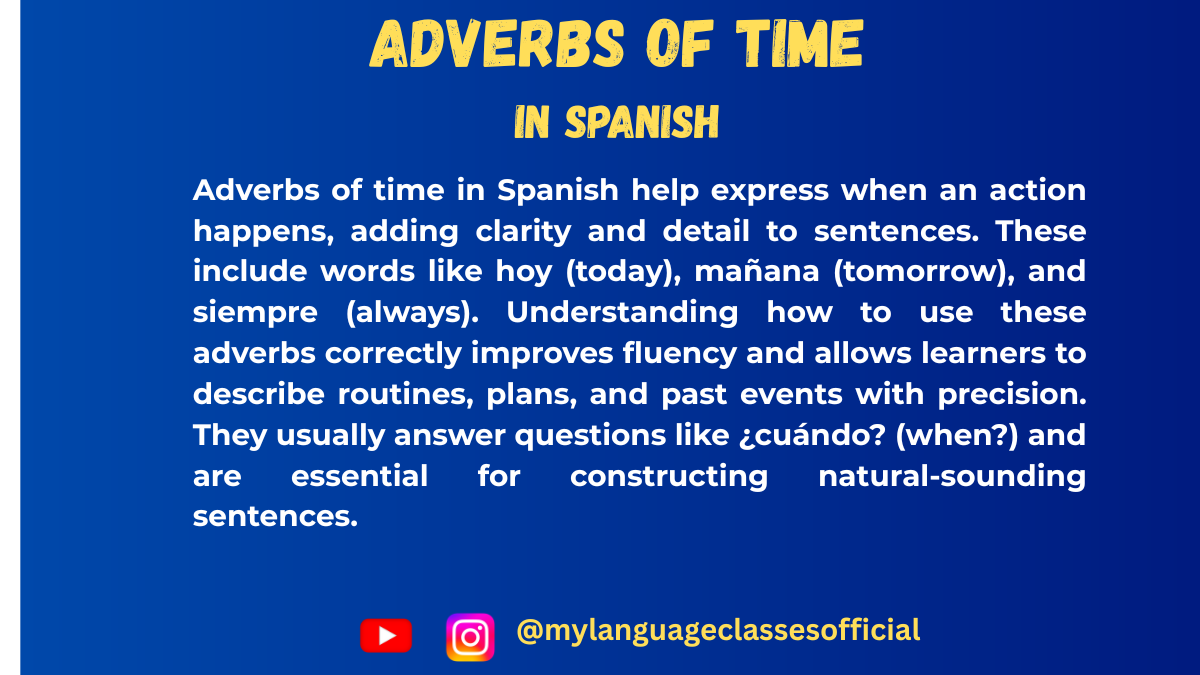
Adverbs of Time in Spanish: A Complete Guide
Adverbs of time (“los adverbios de tiempo”) are essential in Spanish to indicate when an action takes place. They help provide clarity and context to sentences, making conversations more precise. In this article, we will explore common Spanish adverbs of time, their meanings, examples, and grammatical considerations.
What Are Adverbs of Time?
Adverbs of time modify verbs, adjectives, or other adverbs by indicating the timing of an action. They answer questions like ¿Cuándo? (When?) and ¿Cada cuánto tiempo? (How often?).
Common Spanish Adverbs of Time
Here is a list of frequently used adverbs of time in Spanish along with their meanings and example sentences:
1. Adverbs for Specific Points in Time
- Hoy (Today)
- Hoy es un día especial. (Today is a special day.)
- Mañana (Tomorrow)
- Mañana voy al médico. (Tomorrow I am going to the doctor.)
- Ayer (Yesterday)
- Ayer llovió mucho. (Yesterday it rained a lot.)
- Ahora (Now)
- Ahora estoy ocupado. (Now I am busy.)
- Luego (Later)
- Voy al cine, luego te llamo. (I am going to the cinema, later I will call you.)
- Antes (Before)
- Antes de salir, apaga la luz. (Before leaving, turn off the light.)
- Después (After)
- Después de cenar, salimos a caminar. (After dinner, we go for a walk.)
2. Adverbs for Frequency
- Siempre (Always)
- Siempre me levanto temprano. (I always wake up early.)
- Nunca / Jamás (Never)
- Nunca fumo. (I never smoke.)
- Jamás lo volveré a hacer. (I will never do it again.)
- A menudo (Often)
- Voy al gimnasio a menudo. (I go to the gym often.)
- De vez en cuando (From time to time)
- De vez en cuando voy al teatro. (From time to time, I go to the theater.)
- Raramente (Rarely)
- Raramente veo televisión. (I rarely watch TV.)
- Casi nunca (Almost never)
- Casi nunca como comida rápida. (I almost never eat fast food.)
3. Adverbs for Duration
- Todavía / Aún (Still, yet)
- Todavía no he terminado. (I have not finished yet.)
- Ya (Already)
- Ya terminé la tarea. (I already finished the homework.)
- Por fin / Finalmente (Finally)
- Finalmente llegó el paquete. (The package finally arrived.)
- Desde entonces (Since then)
- Desde entonces no hemos hablado. (Since then, we have not spoken.)
- Mientras (While)
- Escucho música mientras estudio. (I listen to music while I study.)
Grammar and Usage Considerations
1. Placement in a Sentence
- In most cases, adverbs of time appear at the beginning or the end of a sentence:
- Hoy tengo clases. (Today I have classes.)
- Tengo clases hoy. (I have classes today.)
- Some adverbs, like ya, are placed before the verb:
- Ya terminé mi trabajo. (I already finished my work.)
2. Agreement and Gender Considerations
- Unlike adjectives, adverbs do not change in gender or number.
- However, some time expressions require articles or prepositions, such as:
- El lunes pasado (Last Monday) vs. Los lunes (On Mondays)
- En la mañana (In the morning) vs. Por la mañana (During the morning)
Forming Adverbs of Time from Adjectives
1. Regular Formation (Adding -mente)
Many adverbs are formed by adding -mente to the feminine singular form of adjectives:
- Rápido (Fast) → Rápidamente (Quickly)
- Frecuente (Frequent) → Frecuentemente (Frequently)
2. Irregular Formation
Some adverbs do not follow the regular -mente rule and must be memorized:
- Bien (Well), Mal (Badly), Tarde (Late), Temprano (Early)
- Example: Él llegó tarde a la reunión. (He arrived late to the meeting.)
3. Using Prepositional Phrases as Adverbs of Time
Some expressions function as adverbs when combined with prepositions:
- De vez en cuando (From time to time)
- Cada día (Every day)
- Hace un rato (A while ago)
Common Mistakes to Avoid
- Confusing “ya” and “todavía”:
- Ya means “already”: Ya hice mi tarea. (I already did my homework.)
- Todavía means “still”: Todavía estoy haciendo mi tarea. (I am still doing my homework.)
- Misplacing “nunca” in negative sentences:
- Correct: Nunca he estado en España. (I have never been to Spain.)
- Incorrect: No he estado nunca en España. (Although this is sometimes used in spoken Spanish, it’s not grammatically preferred.)
Conclusion
Adverbs of time are fundamental for constructing clear and accurate sentences in Spanish. Understanding their placement, variations, and common expressions will enhance your fluency. By practicing these adverbs in different contexts, you will develop a more natural and precise way of speaking Spanish.
If you enjoyed this lesson, be sure to check out more posts like this on my blog at My Language Classes. Don’t forget to subscribe my YouTube channel and follow me on Instagram for the latest language learning tips and lessons. Leave a comment below to share your thoughts, or ask any questions you have.
Happy learning! 😊
- Hoy (Today)
-
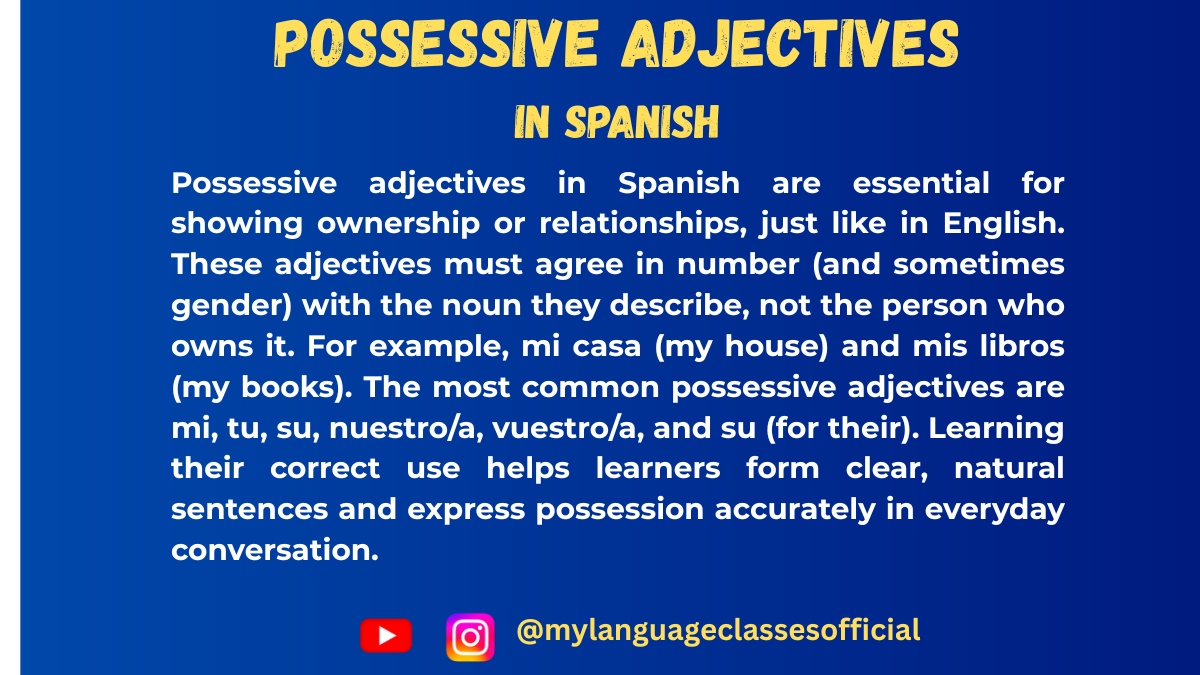
Possessive Adjectives in Spanish
Possessive adjectives in Spanish are essential for indicating ownership or relationships. They agree in gender and number with the noun they modify and are categorized into two forms: short-form possessive adjectives and long-form possessive adjectives.
Short-Form Possessive Adjectives
These adjectives come before the noun and agree only in number (except for “nuestro” and “vuestro,” which also agree in gender).
Singular Possessor Singular Noun Plural Noun mi (my) mi casa (my house) mis casas (my houses) tu (your, informal) tu coche (your car) tus coches (your cars) su (his, her, its, your formal) su perro (his dog) sus perros (his dogs) nuestro/a (our) nuestro amigo (our friend) nuestros amigos (our friends) vuestro/a (your, plural informal) vuestra madre (your mother) vuestras madres (your mothers) su (their, your plural formal) su profesor (their teacher) sus profesores (their teachers) Examples Sentences:
- Mi casa es grande. (My house is big.)
- Tus zapatos son nuevos. (Your shoes are new.)
- Su hermano vive en Madrid. (His brother lives in Madrid.)
- Nuestra escuela es moderna. (Our school is modern.)
- Vuestras mochilas están en la mesa. (Your backpacks are on the table.)
- Sus ideas son interesantes. (Their ideas are interesting.)
Long-Form Possessive Adjectives
These adjectives come after the noun and agree in both gender and number with the noun. They emphasize ownership.
Singular Possessor Singular Masculine Singular Feminine Plural Masculine Plural Feminine mío/a (mine) el libro mío (my book) la casa mía (my house) los libros míos (my books) las casas mías (my houses) tuyo/a (yours, informal) el coche tuyo (your car) la bolsa tuya (your bag) los coches tuyos (your cars) las bolsas tuyas (your bags) suyo/a (his, hers, yours formal) el perro suyo (his dog) la idea suya (her idea) los perros suyos (his dogs) las ideas suyas (her ideas) nuestro/a (ours) el amigo nuestro (our friend) la profesora nuestra (our teacher) los amigos nuestros (our friends) las profesoras nuestras (our teachers) vuestro/a (yours, plural informal) el coche vuestro (your car) la casa vuestra (your house) los coches vuestros (your cars) las casas vuestras (your houses) suyo/a (theirs, yours plural formal) el libro suyo (their book) la comida suya (their food) los libros suyos (their books) las comidas suyas (their foods) Examples Sentences:
- Esa mochila es mía. (That backpack is mine.)
- El coche rojo es tuyo. (The red car is yours.)
- La casa grande es suya. (The big house is his/hers.)
- La responsabilidad es nuestra. (The responsibility is ours.)
- El problema es vuestro. (The problem is yours.)
- Las ideas son suyas. (The ideas are theirs.)
Key Differences Between Short and Long Forms
- Position in the sentence: Short forms come before the noun; long forms come after the noun.
- Emphasis: Long forms emphasize possession and ownership more strongly.
- Agreement: Long forms agree in both gender and number, whereas short forms only change for number (except “nuestro” and “vuestro”).
Common Expressions Using Possessive Adjectives
Here are some useful phrases commonly used in daily life:
Spanish English Mi amor My love Mi casa es tu casa My house is your house (Feel at home) A su servicio At your service En su tiempo libre In his/her free time A mi manera In my way A su gusto To his/her liking Nuestros pensamientos Our thoughts Vuestra responsabilidad Your responsibility Lo mío es importante What is mine is important Un amigo mío A friend of mine Example Sentences Using Expressions:
- Mi casa es tu casa, siéntete cómodo. (My house is your house, make yourself comfortable.)
- A su gusto, puede elegir cualquier opción. (To his/her liking, they can choose any option.)
- En su tiempo libre, le gusta leer. (In his/her free time, he/she likes to read.)
- Nuestros pensamientos son similares. (Our thoughts are similar.)
Things to Keep in Mind When Using Possessive Adjectives
- Article Usage: Short-form possessive adjectives do not need an article, while long-form adjectives can be used with definite articles (el, la, los, las):
- Mi coche es rojo. (My car is red.)
- El coche mío es rojo. (The car of mine is red.)
- Plural and Gender Agreement:
- If the noun is plural, the possessive adjective must be plural.
- If the noun is feminine, adjectives ending in -o change to -a (e.g., “mío” → “mía”).
- Ambiguity of “su/sus”: “Su” and “sus” can mean “his, her, their, your (formal),” leading to confusion. To clarify, use “de + pronoun/name”:
- Su coche es nuevo. (His/her/your/their car is new.)
- El coche de Juan es nuevo. (Juan’s car is new.)
- El coche de ellos es nuevo. (Their car is new.)
Final Thoughts
Possessive adjectives are an integral part of Spanish grammar, making conversations clearer and more precise. Understanding the difference between short and long forms, as well as their proper agreement with nouns, will greatly improve your fluency. Practice using these adjectives in daily conversations, and soon, they’ll become second nature!
Did you find this guide helpful?
Let us know in the comments below or practice by writing a few sentences using possessive adjectives!
If you enjoyed this lesson, be sure to check out more posts like this on my blog at My Language Classes. Don’t forget to subscribe my YouTube channel and follow me on Instagram for the latest language learning tips and lessons. Leave a comment below to share your thoughts, or ask any questions you have.
Happy learning! 😊
-

Modal Verbs in Spanish: A Complete Guide
Modal verbs in Spanish, known as verbos modales, are auxiliary verbs that help express necessity, ability, permission, obligation, or possibility. Just like in English, they are followed by an infinitive verb and modify its meaning. Understanding these verbs is essential for mastering Spanish and communicating effectively in daily situations.
Common Modal Verbs in Spanish
Here are the most frequently used modal verbs in Spanish:
- Poder (to be able to, can) – Expresses ability or permission
- Querer (to want, to wish) – Indicates desire or intention
- Deber (must, should, ought to) – Expresses obligation or probability
- Tener que (to have to) – Indicates necessity or obligation
- Haber de (to have to, should) – Expresses mild obligation or intention
- Saber (to know how to) – Expresses ability when used with an infinitive
- Soler (to usually do something) – Describes habitual actions
Usage and Sentence Structures
1. Poder – Expressing Ability and Permission
Conjugation Example (Present Tense):
- Yo puedo
- Tú puedes
- Él/Ella/Usted puede
- Nosotros/Nosotras podemos
- Vosotros/Vosotras podéis
- Ellos/Ellas/Ustedes pueden
Example Sentences:
- Puedo hablar español. (I can speak Spanish.)
- ¿Puedes ayudarme? (Can you help me?)
- No puedes entrar sin permiso. (You cannot enter without permission.)
2. Querer – Expressing Desire or Intention
Conjugation Example (Present Tense):
- Yo quiero
- Tú quieres
- Él/Ella/Usted quiere
- Nosotros/Nosotras queremos
- Vosotros/Vosotras queréis
- Ellos/Ellas/Ustedes quieren
Example Sentences:
- Quiero aprender español. (I want to learn Spanish.)
- ¿Quieres un café? (Do you want a coffee?)
- Ella quiere viajar por el mundo. (She wants to travel around the world.)
3. Deber – Expressing Obligation or Probability
Conjugation Example (Present Tense):
- Yo debo
- Tú debes
- Él/Ella/Usted debe
- Nosotros/Nosotras debemos
- Vosotros/Vosotras debéis
- Ellos/Ellas/Ustedes deben
Example Sentences:
- Debes estudiar más. (You should study more.)
- Debemos respetar a los demás. (We must respect others.)
- Esto debe ser importante. (This must be important.)
4. Tener que – Expressing Necessity
Conjugation Example (Present Tense):
- Yo tengo que
- Tú tienes que
- Él/Ella/Usted tiene que
- Nosotros/Nosotras tenemos que
- Vosotros/Vosotras tenéis que
- Ellos/Ellas/Ustedes tienen que
Example Sentences:
- Tengo que trabajar mañana. (I have to work tomorrow.)
- ¿Tienes que irte ahora? (Do you have to leave now?)
- Ellos tienen que hacer la tarea. (They have to do their homework.)
5. Haber de – Expressing Mild Obligation or Intention
Example Sentences:
- He de llamarte más tarde. (I have to call you later.)
- Has de saber la verdad. (You should know the truth.)
6. Saber – Expressing Ability or Knowledge
Example Sentences:
- Sé nadar muy bien. (I know how to swim very well.)
- ¿Sabes tocar la guitarra? (Do you know how to play the guitar?)
7. Soler – Expressing Habitual Actions
Example Sentences:
- Suelo levantarme temprano. (I usually wake up early.)
- ¿Sueles ir al gimnasio? (Do you usually go to the gym?)
Conjugation and Verb Formation Rules
Regular Verb Conjugation in Present Tense
AR verbs: hablar (to speak)
- Yo hablo
- Tú hablas
- Él/Ella/Usted habla
- Nosotros/Nosotras hablamos
- Vosotros/Vosotras habláis
- Ellos/Ellas/Ustedes hablan
ER verbs: comer (to eat)
- Yo como
- Tú comes
- Él/Ella/Usted come
- Nosotros/Nosotras comemos
- Vosotros/Vosotras coméis
- Ellos/Ellas/Ustedes comen
IR verbs: vivir (to live)
- Yo vivo
- Tú vives
- Él/Ella/Usted vive
- Nosotros/Nosotras vivimos
- Vosotros/Vosotras vivís
- Ellos/Ellas/Ustedes viven
Irregular Modal Verbs Conjugation in Present Tense
Poder (o→ue change)
- Yo puedo
- Tú puedes
- Él/Ella/Usted puede
- Nosotros/Nosotras podemos
- Vosotros/Vosotras podéis
- Ellos/Ellas/Ustedes pueden
Querer (e→ie change)
- Yo quiero
- Tú quieres
- Él/Ella/Usted quiere
- Nosotros/Nosotras queremos
- Vosotros/Vosotras queréis
- Ellos/Ellas/Ustedes quieren
Things to Keep in Mind
- Articles and Gender: Modal verbs are always followed by an infinitive verb, but nouns used in the sentence must agree in gender and number.
- Example: Debes comprar la mesa (You must buy the table – ‘mesa’ is feminine).
- Plurality: Modal verbs do not change based on the plurality of the infinitive verb.
- Example: Puedes comprar los libros (You can buy the books).
- Sentence Structure: Modal verbs follow a Subject + Modal Verb + Infinitive structure.
- Example: Ella quiere bailar (She wants to dance).
Conclusion
Mastering modal verbs in Spanish is crucial for fluency and natural conversation. Whether you’re asking for permission, expressing obligation, or stating an ability, these verbs will help you communicate effectively. Keep practicing their conjugations and use them in real-life situations to improve your Spanish proficiency!
If you enjoyed this lesson, be sure to check out more posts like this on my blog at My Language Classes. Don’t forget to subscribe my YouTube channel and follow me on Instagram for the latest language learning tips and lessons. Leave a comment below to share your thoughts, or ask any questions you have.
Happy learning! 😊
-
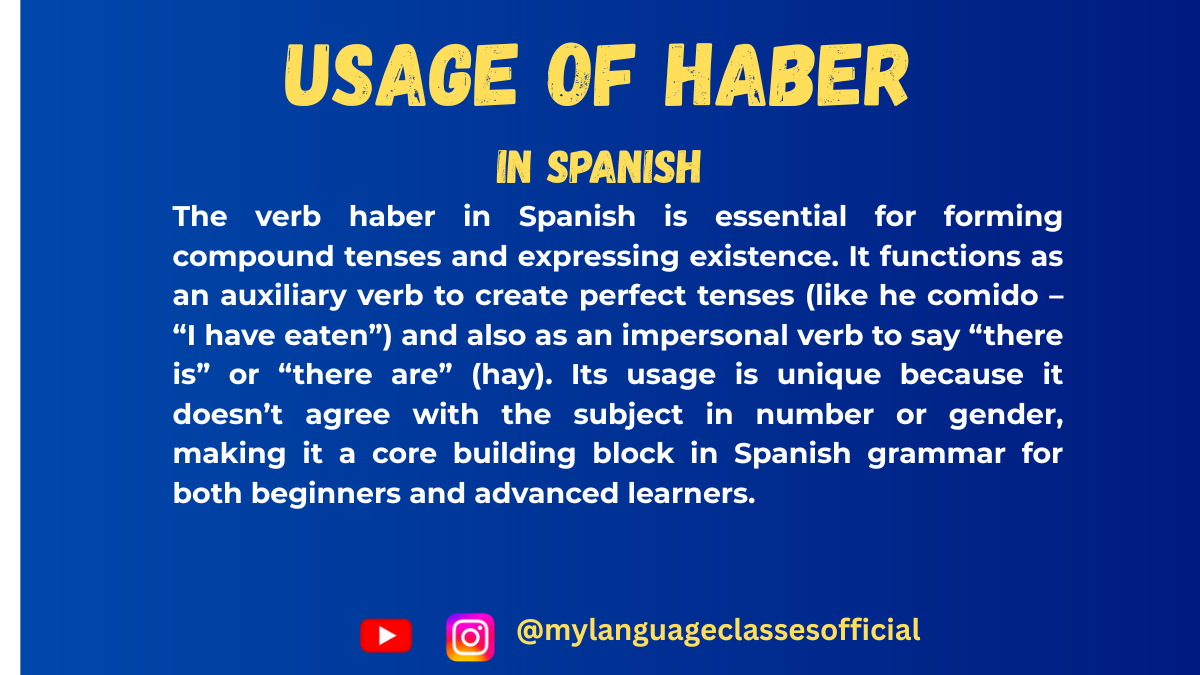
Mastering “Haber” in Spanish
The Spanish verb haber is one of the most versatile and fundamental verbs in the language. Understanding its uses, forms, and common expressions is essential for communicating effectively in Spanish. In this blog post, we will explore the different contexts in which “haber” is used, along with a list of commonly used expressions and examples.
1. What Is “Haber”?
“Haber” is an irregular verb in Spanish that serves multiple grammatical purposes. It does not directly translate into English but has different meanings and uses depending on the context. It can function as:
- An auxiliary verb: To form compound tenses.
- An impersonal verb: To express existence.
- Part of idiomatic expressions: Used in fixed phrases common in daily speech.
2. Forms of “Haber”
The conjugation of “haber” varies greatly depending on the tense and mood. Here are some key forms:
Present tense (indicative):
- He, has, ha, hemos, habéis, han
Past tense (preterite):
- Hube, hubiste, hubo, hubimos, hubisteis, hubieron
Imperfect tense:
- Había, habías, había, habíamos, habíais, habían
Subjunctive mood (present):
- Haya, hayas, haya, hayamos, hayáis, hayan
Impersonal form (used in expressions):
- Hay (present), hubo (preterite), había (imperfect)
3. Key Uses of “Haber”
A. As an Auxiliary Verb
“Haber” is used to form compound tenses, similar to “have” in English. It combines with the past participle of the main verb.
- Present Perfect (Pretérito Perfecto): Used to talk about actions that happened in the past but are relevant to the present.
- Example: He comido. (I have eaten.)
- Past Perfect (Pluscuamperfecto): Describes actions that occurred before another past action.
- Example: Había estudiado antes del examen. (I had studied before the exam.)
- Future Perfect (Futuro Perfecto): Refers to actions that will have been completed by a certain point in the future.
- Example: Habré terminado para las cinco. (I will have finished by five.)
B. As an Impersonal Verb
“Haber” is used in its impersonal form to express existence. The subject is not a person, and it is typically followed by a noun.
- Present Tense:Hay (There is/There are)
- Example: Hay un libro en la mesa. (There is a book on the table.)
- Example: Hay muchas flores en el jardín. (There are many flowers in the garden.)
- Past Tense:
- Hubo (preterite): Refers to events or existence at a specific moment in the past.
- Example: Hubo un accidente en la carretera. (There was an accident on the road.)
- Había (imperfect): Describes an ongoing or habitual past situation.
- Example: Había mucha gente en la fiesta. (There were many people at the party.)
- Hubo (preterite): Refers to events or existence at a specific moment in the past.
- Future Tense:Habrá (There will be)
- Example: Habrá una reunión mañana. (There will be a meeting tomorrow.)
C. Common Expressions with “Haber”
Here are some of the most common idiomatic expressions with “haber,” their meanings, and example sentences:
- Hay que + infinitive
Meaning: One must/It is necessary to.- Example: Hay que estudiar para aprobar el examen. (One must study to pass the exam.)
- Haber de + infinitive
Meaning: To have to (mild obligation or future intention).- Example: He de hablar con ella. (I must talk to her.)
- Haber lugar
Meaning: To have room or to be possible.- Example: No hay lugar para más invitados. (There is no room for more guests.)
- No hay de qué
Meaning: You’re welcome (literally, there is no reason to thank).- Example: Gracias por tu ayuda. No hay de qué. (Thanks for your help. You’re welcome.)
- Haber que ver con
Meaning: To have to do with something.- Example: Eso no tiene nada que ver conmigo. (That has nothing to do with me.)
- Habérselas con alguien
Meaning: To deal with someone (often confrontational).- Example: Hoy me las he tenido que ver con mi jefe. (Today, I had to deal with my boss.)
4. Things to Keep in Mind
When using “haber,” remember the following:
Articles and Gender:
- “Haber” in its impersonal form (hay, hubo, habrá) is not influenced by the gender or plurality of the noun that follows.
- Correct: Hay una silla. (There is a chair.)
- Correct: Hay cinco sillas. (There are five chairs.)
Auxiliary Verb Agreement:
- When used as an auxiliary verb, “haber” agrees with the subject of the sentence, not the object.
- Correct: He visto la película. (I have seen the movie.)
Idiomatic Nuance:
- Expressions like hay que are impersonal and do not conjugate for different subjects.
5. Practice and Examples
To master “haber,” practice by forming sentences in different tenses and exploring idiomatic expressions. For example:
- Hay un perro en el parque. (There is a dog in the park.)
- Había una vez un rey. (Once upon a time, there was a king.)
- Habrá una gran sorpresa en la fiesta. (There will be a big surprise at the party.)
Final Thoughts
Mastering “haber” is a key step in becoming fluent in Spanish. Whether forming compound tenses, expressing existence, or using idiomatic expressions, this verb is integral to daily communication. Keep practicing, and soon, it will become second nature.
Do you have favorite expressions with “haber”? Share them in the comments!
If you enjoyed this lesson, be sure to check out more posts like this on my blog at My Language Classes. Don’t forget to subscribe my YouTube channel and follow me on Instagram for the latest language learning tips and lessons. Leave a comment below to share your thoughts, or ask any questions you have.
-
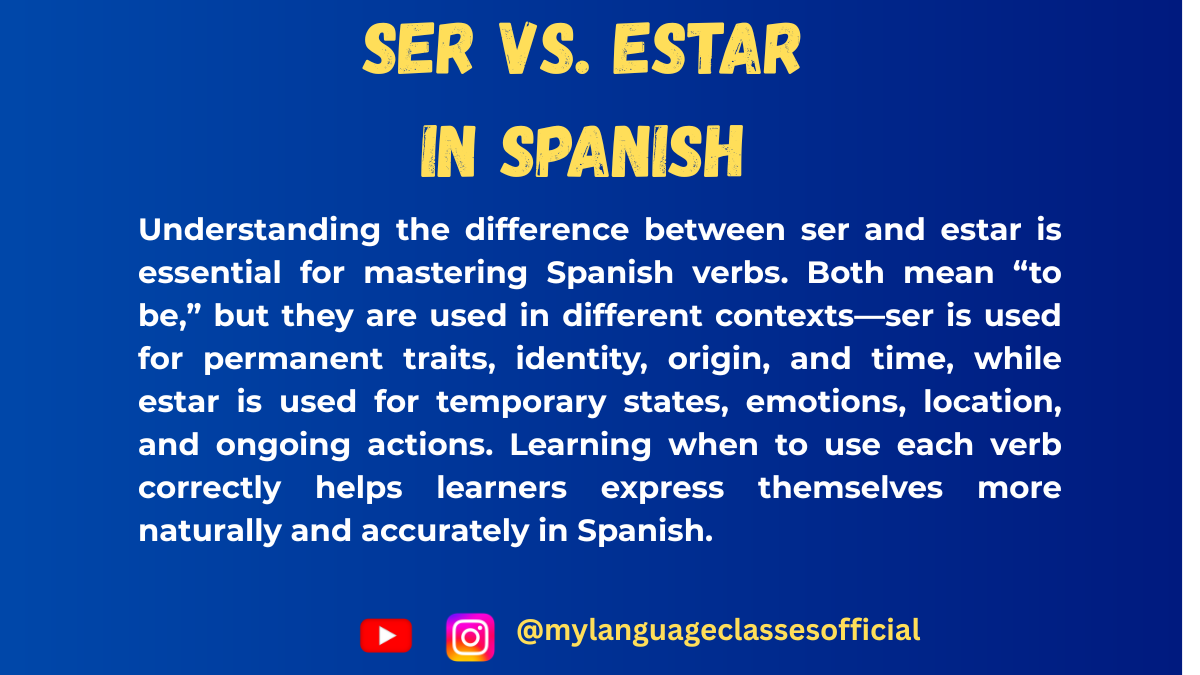
Use of Ser vs. Estar in Spanish
One of the first challenges for English speakers learning Spanish is understanding the difference between ser and estar, two verbs that both translate to “to be” in English. While they may seem interchangeable at first glance, their uses are distinct and crucial for speaking Spanish correctly.
Let’s dive into their differences, common expressions, and practical tips to master them.
The Core Difference
Ser
Ser is used to describe essential characteristics, identity, and things that are inherent or permanent.
Estar
Estar is used to describe temporary states, locations, and conditions.
When to Use Ser
- Identity & Characteristics
- To identify someone or something:
- Soy estudiante. (I am a student.)
- To describe physical or personality traits:
- Ella es alta y simpática. (She is tall and friendly.)
- To identify someone or something:
- Origin and Nationality
- To talk about where someone is from:
- Somos de México. (We are from Mexico.)
- To talk about where someone is from:
- Time and Dates
- For time expressions:
- Son las tres. (It is three o’clock.)
- For dates:
- Hoy es lunes. (Today is Monday.)
- For time expressions:
- Professions
- To state occupations:
- Él es doctor. (He is a doctor.)
- To state occupations:
- Possession
- To indicate ownership:
- Este libro es mío. (This book is mine.)
- To indicate ownership:
- Events
- To say where or when an event occurs:
- La reunión es en la oficina. (The meeting is in the office.)
- To say where or when an event occurs:
When to Use Estar
- Temporary States and Conditions
- To express emotions or physical conditions:
- Estoy feliz. (I am happy.)
- Ellos están cansados. (They are tired.)
- To express emotions or physical conditions:
- Location
- To describe where something or someone is (except events):
- El libro está en la mesa. (The book is on the table.)
- Estamos en casa. (We are at home.)
- To describe where something or someone is (except events):
- Ongoing Actions
- To form the present progressive:
- Estoy estudiando. (I am studying.)
- Están bailando. (They are dancing.)
- To form the present progressive:
- Result of Actions
- To indicate the result of a previous action:
- La ventana está abierta. (The window is open.)
- To indicate the result of a previous action:
Common Expressions Using Ser and Estar
Here’s a list of expressions frequently used in daily Spanish conversation:
Expressions with Ser
- Ser pan comido – To be a piece of cake (easy)
- Este examen es pan comido. (This exam is a piece of cake.)
- Ser un/a cabezota – To be stubborn
- Eres un cabezota. (You are stubborn.)
- Ser buena/mala gente – To be a good/bad person
- Mi abuela es buena gente. (My grandmother is a good person.)
- Ser el colmo – To be the last straw
- ¡Esto es el colmo! (This is the last straw!)
Expressions with Estar
- Estar de acuerdo – To agree
- ¿Estás de acuerdo? (Do you agree?)
- Estar en las nubes – To be daydreaming
- Hoy estás en las nubes. (Today you are daydreaming.)
- Estar de buen/mal humor – To be in a good/bad mood
- Estoy de buen humor. (I’m in a good mood.)
- Estar hasta las narices – To be fed up
- Estoy hasta las narices de esto. (I’m fed up with this.)
Tips for Mastering Ser and Estar
- Context is Key
Always ask yourself: Is this describing a permanent trait (ser) or a temporary state (estar)? - Gender and Plurality Agreement
Both ser and estar must agree with the subject in gender and number:- Ella es inteligente. (She is intelligent.)
- Ellos están contentos. (They are happy.)
- Articles and Adjectives
When describing something, ensure articles (e.g., el, la, los, las) and adjectives agree with the subject:- La casa es grande. (The house is big.)
- Las puertas están cerradas. (The doors are closed.)
- Practice Set Phrases
Memorizing idiomatic expressions with ser and estar will help you sound natural.
Example Sentences
- Ser
- Mi hermano es médico. (My brother is a doctor.)
- El cielo es azul. (The sky is blue.)
- Estar
- La comida está fría. (The food is cold.)
- Estoy en el parque. (I am in the park.)
By mastering the nuances of ser and estar, you’ll be able to express yourself with clarity and confidence in Spanish. Keep practicing, and soon these distinctions will feel natural!
If you enjoyed this lesson, be sure to check out more posts like this on my blog at My Language Classes. Don’t forget to subscribe my YouTube channel and follow me on Instagram for the latest language learning tips and lessons. Leave a comment below to share your thoughts, or ask any questions you have.
- Identity & Characteristics
-
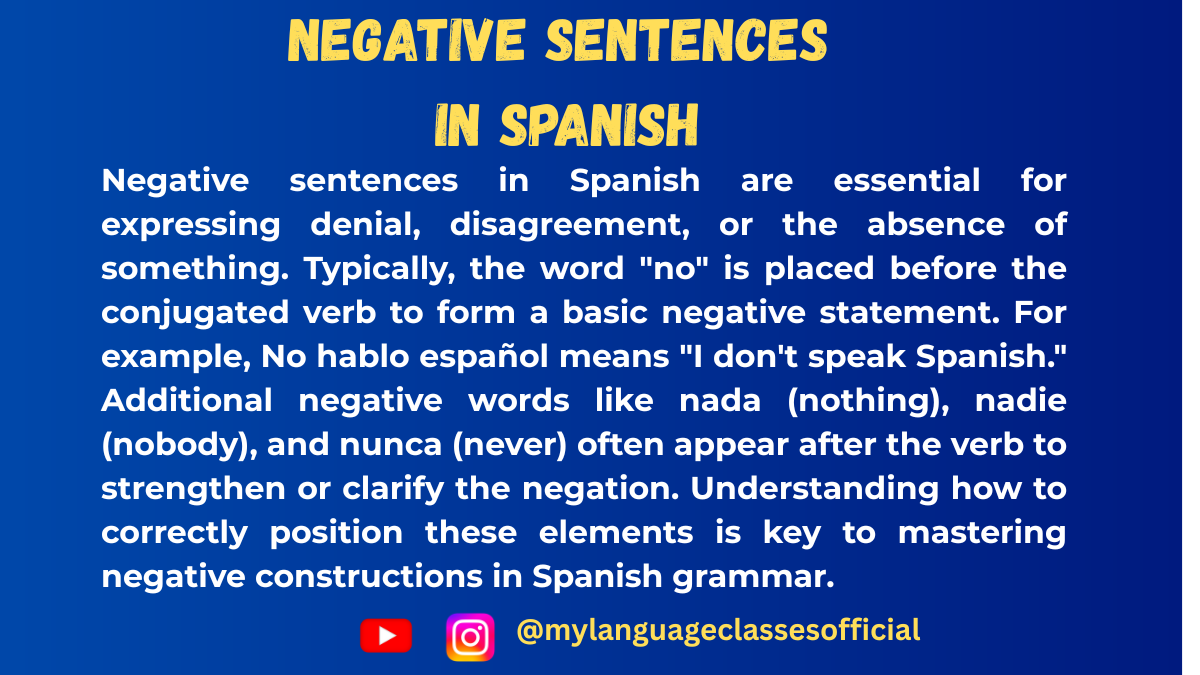
Negative Sentences in Spanish
When learning Spanish, mastering negative sentences is essential for effective communication. Negative sentences allow you to deny, contradict, or express the absence of something. This blog post will guide you through the rules, structures, and common considerations when constructing negative sentences in Spanish, including gender, articles, and plurals.
Basic Structure of Negative Sentences
In Spanish, the word “no” is the key to forming negative sentences. It is placed before the verb.
Examples:
- Affirmative: María canta bien. (María sings well.)
- Negative: María no canta bien. (María does not sing well.)
The structure is straightforward:
Subject + “no” + verb + complement.
Using Negative Words
In Spanish, additional negative words reinforce or replace “no.” These include:
- nada (nothing)
- nadie (nobody)
- ningún/ninguno/ninguna (none, no one)
- nunca (never)
- tampoco (neither)
Double Negatives
Unlike English, double negatives are not only acceptable but required in Spanish. For instance:
- No veo nada. (I don’t see anything.)
- No conozco a nadie. (I don’t know anyone.)
- No estudio nunca. (I never study.)
Here, “no” works in harmony with other negative words.
Gender and Plural Considerations
1. Gender Agreement
Negative words like ninguno and ninguna must agree with the gender of the noun they modify.
- Masculine singular:
No tengo ningún problema. (I don’t have any problem.) - Feminine singular:
No tengo ninguna idea. (I don’t have any idea.)
2. Plural Agreement
In most cases, ninguno is not pluralized, except in specific cases like inherently plural nouns:
- No tengo ningunas vacaciones este año. (I don’t have any vacations this year.)
Position of Negative Words
1. Before the Verb
Negative words like “no” are typically placed before the verb:
- No quiero comer. (I don’t want to eat.)
2. After the Verb
Other negative words may follow the verb for emphasis:
- No quiero nada. (I don’t want anything.)
If a subject pronoun is omitted (common in Spanish), pay attention to word order:
- Nadie sabe la respuesta. (Nobody knows the answer.)
Common Mistakes to Avoid
- Forgetting Double Negatives
Avoid translating English structures directly. Saying No sé algo instead of No sé nada is incorrect. - Ignoring Gender and Number Agreement
Ensure that words like ninguno/ninguna match the noun’s gender and number. - Mixing Articles Incorrectly
When using negative words, omit definite articles unless emphasizing specificity:
- Incorrect: No tengo la idea.
- Correct: No tengo idea.
Practical Tips
- Practice with Examples
Write affirmative and negative versions of sentences:
- Ella siempre llega a tiempo. (She always arrives on time.)
- Ella nunca llega a tiempo. (She never arrives on time.)
- Use Context to Choose Negative Words
- Use nada for “nothing” or “anything.”
- Use nadie when referring to “nobody” or “anybody.”
- Practice Conversations
Create scenarios to apply double negatives naturally:
- No tengo nada que decir. (I have nothing to say.)
Mastering negative sentences in Spanish opens up new possibilities for nuanced communication. Practice regularly, pay attention to gender and number agreement, and soon, negatives will become second nature.
¡Buena suerte! (Good luck!)
If you enjoyed this lesson, be sure to check out more posts like this on my blog at My Language Classes. Don’t forget to subscribe my YouTube channel and follow me on Instagram for the latest language learning tips and lessons. Leave a comment below to share your thoughts, or ask any questions you have.
Happy learning! 😊

